#equatorial docking bay
Explore tagged Tumblr posts
Text
Escaping the Blockade

STAR WARS EPISODE I: The Phantom Menace 00:26:39
#Star Wars#Episode I#The Phantom Menace#Naboo Royal Starship#Lucrehulk-class LH-3210#Trade Federation battleship#Trade Federation blockade#Blockade of Naboo#Naboo#tractor array power system#Commander Ric Olié#R2-D2#R2 unit#astromech droid#centersphere#equatorial docking bay#reinforced bracing#primary docking claw#rotator assembly
0 notes
Text
Thursday, September 19 - Luganville, Vanuatu










Yesterday was a grey, windy and rainy day - so it was good it was a sea day and we could enjoy lectures, trivia, chatting with friends and generally being glad we didn't have any outings planned. Today, however, dawned sunny and lovely, and we noticed a definite change in the air. Now that we are 15 degrees south, the air is definitely cooler and drier, although it's still hot in the sun. We are out of the equatorial zone and into the trades, and the worst of the heat and humidity is probably behind us (not that it was ever that bad, especially on the ship).
Vanuatu is a Melanesian nation of thirteen main and many smaller islands that achieved independence in 1980. Before that it was known as the New Hebrides and was governed by a "condominium" (yes, that's actually the word they use) government that was an agreement between the French and UK governments. As a result, there are usually three languages on any sign - English, French and the local pidgen, which is a combination. The islands are grouped into several zones, like states, each comprising several principal islands. We docked at the largest island, although the capital of the country is further south
Vanuatu is trying to promote tourism, but has had several setbacks and today illustrated part of the problem. P&O Cruise Lines had made this a fairly regular stop, so a nice facility was built and many small cars were bought for taxis to facilitate island visits. However, this is not a regular stop at the moment, so tours are a bit haphazard. We were supposed to be here from around 10 AM to 6 PM, and there were several included tours that had been arranged with the locals, as well as deployments of the submarine to a site where there were wrecks from WWII. However, when we arrived and the clearance people from Vanuatu met with our purser, we were suddenly told we would be leaving at 3:45, and the submarine and last tour of the day were cancelled.
One of the main crops here revolves around coconuts, and they currently have an infestation of the coconut rhinoceros beetle, which is mainly nocturnal. It seems that they swarm in the evening, are attracted by lights, and as such all ships need to be away and out of the archipelago before dark. Oops - it seems that didn't translate to the tour operators, and our ship wasn't informed until the clearance this morning. Perhaps we could have arrived sooner if we had known, but it made for a somewhat abbreviated day, and does not bode well for cruise ship tourism.
Since we were on the earliest tour we weren't affected, and were able to leave shortly after 11 AM on our "Riri River and Blue Hole" adventure. Luganville is quite small and we were shortly out in the countryside, which was completely different from previous stops. Here much of the forest had been cleared long ago along the main road, and there were large cattle ranches, with sparsely planted coconut palms. Our guide said that the cattle help keep the forest at bay so that the palms can grow without competition from other trees and shrubs, but it still looked a little strange after seeing all the other islands with only pigs and chickens.
We arrived at our river after about a twenty minute drive and unloaded to find a variety of outrigger canoes waiting, as well as a pile of assorted life vests that really fit no one. Unfortunately, there weren't enough canoes for everyone who arrived after we did, so the guides had to paddle back to the start after dropping off their passengers at the "blue hole". In our canoe, our guide had an extra paddle that we took turns using - unfortunately it was very waterlogged and heavy, but it did the job.
The river was incredibly clear and blue, since it was spring fed at the blue hole, and it was a short, but quite lovely trip along well-vegetated banks. Once we disembarked at the end, we were able to go for a swim in delightfully cool and clear water. It was lovely to swim in something other than salt water for a change, and before we knew it we had to scramble out, dry off a bit and walk a short way to the vans and then ride back to the pier. Our van guide stopped and got us a sprouted coconut, which we tasted as she told us about all the ways the coconut is used at all stages - no wonder they are so worried about the beetle!.
Although it was too bad we didn't have longer in this port, it was nice to see a little of the area, which appears far more prosperous than many of the islands we have been to recently. The housing is more western, with "traditional" materials such as thatching mostly used on special buildings, and there were none of the roadside hits selling little snacks and top-up phone cards like in PNG or Micronesia. But they do need to up their game with tours (the van part was quite professional, while the river part was much less so) if they are going to keep tourists coming, especially with the time limitations.
We had a beautiful sail away from the main island as we made our way past other smaller islands and finally out away into the sea. Tomorrow will be another sea day while we make some distance towards Fiji, our next stop.
0 notes
Text
Was anybody going to tell me Thedas has two moons or was I supposed to find that out while trying to research trade routes myself?
Anyway, I have thoughts about that and spent far, far too much of my night on this.
Laying it out:
We know the second moon is named Satina, but since we don’t know the name of the other, I’m going to call them the primary moon (big boy) and second moon (little guy) when I do refer to them directly. They would have different orbital periods (which should affect the calendar more, but whatever) and both have an equatorial orbit (like our moon does!). These are presumptions, but they’re also how things usually work. Especially considering that Thedas is habitable. That’s important to maintain.
Also, whenever I look at maps of Thedas in detail, I’m reminded that this has to be a teeny tiny planet. That’s not really relevant to this post, but it’s weird to think about.
The main thing covered here will be the effect of this on the tides, but first:
Flavor:
There are two moons in the sky! That’s neat and cool to look at! They would both reflect the sun’s light, so that would make nights brighter. This would have evolutionary effects, potentially, but that’s enough of a technicality in the fast and loose world of Thedas that I’ll pass it by right now. There would be more eclipses, which is also neat. Unfortunately, we never see both of them at once in the games, but here’s a mod to have two moons overhead in the Hissing Wastes.
Tidal effect:
This part is really long. Under the cut!
The primary moon, which we see in the sky in the Hissing Wastes, is either very large or very close in comparison to Earth’s moon (proportionally). Since Earth’s moon is improbably large, it’s more likely that it’s very close, which actually has a more significant effect on its tidal pull than size would (proximity > size; we see this IRL with how minimal the Sun’s affect is on Earth’s tides). The second moon is presumably smaller and further away, but its proximity still has a significant effect on tides.
Most of the time they would balance each other out to a relatively normal cycle, but high tides would be higher on average. Not catastrophically, but higher – and dramatically so when the moons enter orbital resonance (same place in orbit at the same time) and both of their gravitational pulls have affect at the same time!
Initially I thought that that would greatly impact coastal settlements and trade hubs, and it would, but not many that we’re super familiar with. Tides are greater with greater bodies of water, and a lot of the trade centers we see are around the Waking and Shining Seas (Kirkwall, Highever, etc.). They’re just little guys. Western Thedas is mostly landlocked as well, and all of Thedas is sub-equatorial; tidal pull with an equatorial moon decreases the further you are from the equator, since you’re further from the moon(s).
Let's look at some maps! Mostly using the map from Tevinter Nights for reference here:
Cities that aren't named are marked by little symbols that look like houses. I'll give crops of each location for a visual as we go, because everything is small.
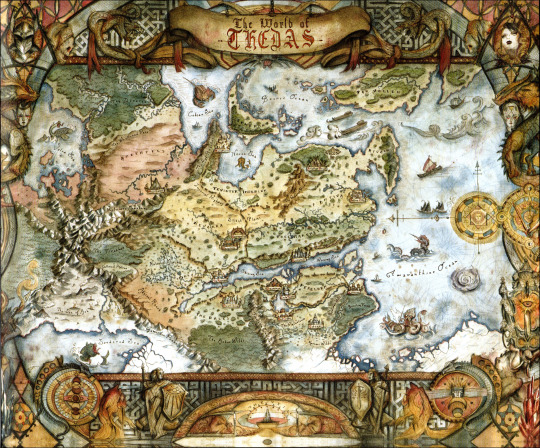
Other major coastal regions:
- Tevinter is predominantly coastal at this point in history, but the Nocen Sea isn’t enormous; Seheron is quite close on the other side; and the coast around the Arlathan forest isn’t populated.
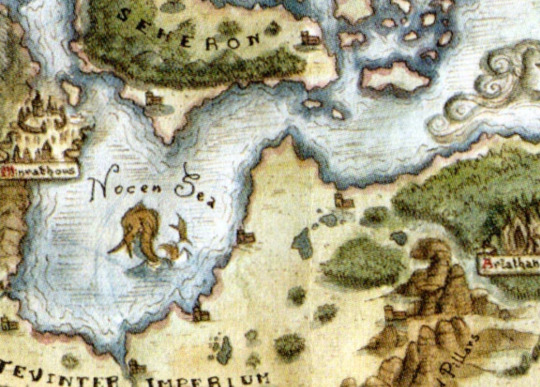
- The eastern Ander coast is paralleled across the Colean Sea by a Tevinter peninsula, if they actually make use of that coast.

- Antiva isn’t notably populated north of the White Spire (the Antivan mountain, not the Orlesian Circle Tower, which has given me some grief); its coastal population is on the Rialto Bay.
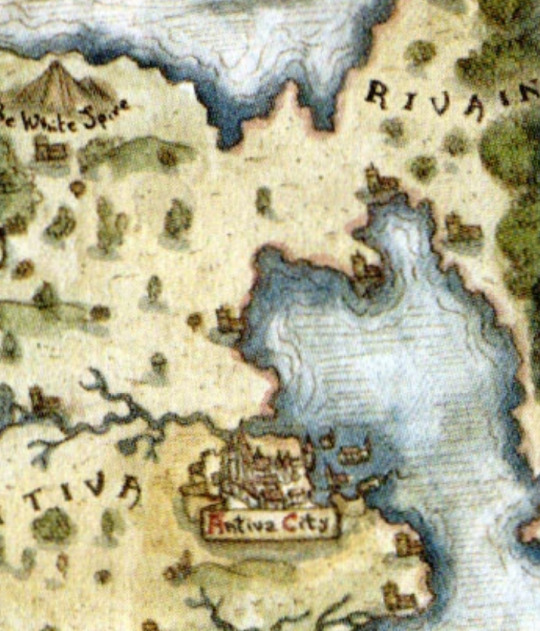
- Eastern Ferelden has a significant amount of coastline, but the Brecilian Forest blocks most of it off, and Gwaren (city south of the Forest) is far south enough that it’s probably bordering the planet’s Antarctic circle.
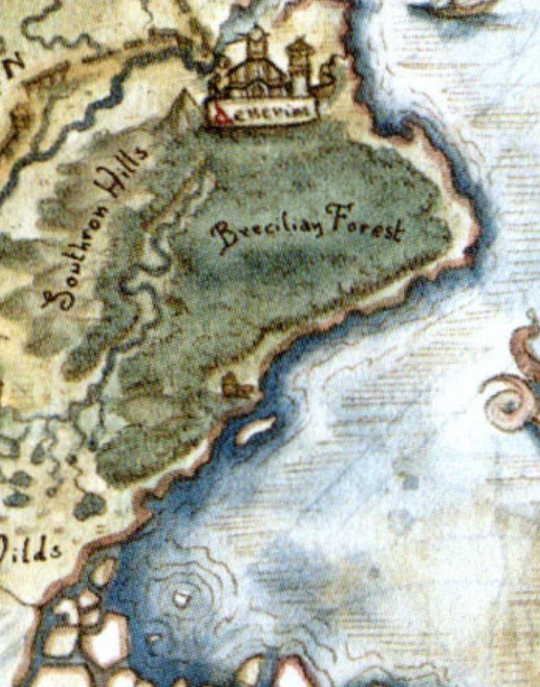
- Those little northwestern Fereldan islands don't have coastal focuses. Image from the wiki used because Alamar's tiny.
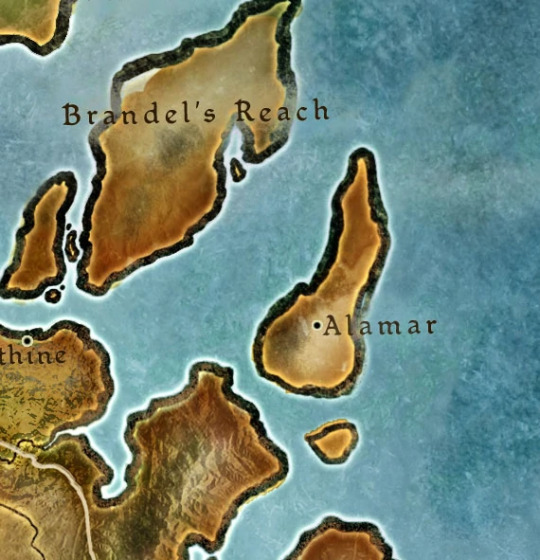
- Northern Seheron would be affected. We don’t know the concentrations of Seheron’s population. Much of Par Vollen would also be affected and the same holds true for them, but their technology (extremely seaworthy vessels, extreme perseverance, etc.) and cultural mindset lends to the idea that they would use the tides to their advantage strategically, as well as take advantage of the major boons spring tide would have on fishing! When the tide is coming in to its highest, it shakes things up and brings in all the fish.

- Rivain isn’t notably populated east of its dominating mountains. Its major population centers are in the Southeast, on the Rialto Bay. Except Llomeryn. Rivain, as descendants of seafaring islanders, would have a long cultural history of being able to deal with this anyway. Why is Llomeryn (little house icon on the east coast of the southern island) on that side? I don’t know. It doesn’t make sense. It’s fine.
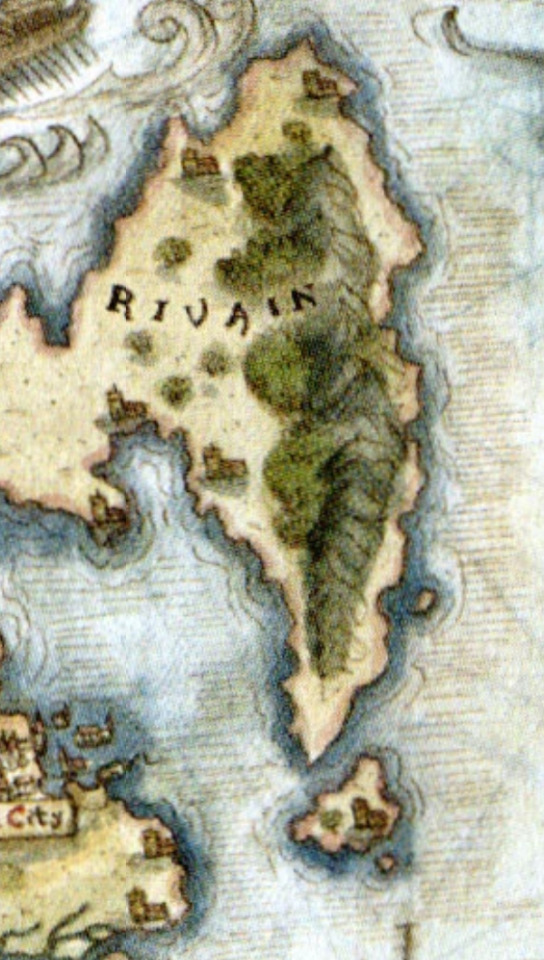
- I’m sure that Estwatch is doing just fine. They can handle themselves.
- Wycome is a major fishing hot-spot, taking advantage of the fishy boons the tides provide.
- Hercinia is coping, I guess.
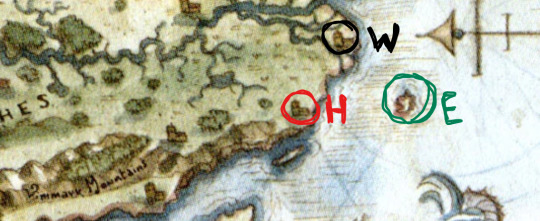
In regards to coastal port cities on the Amaranthine ocean – the largest body of water on the map – a special situation may exist where they have ports designed to accommodate the very high high tides when they come in (how often would depend on the moons’ orbital periods and how often they are in orbital resonance). I’m sure there are examples of docks and ports designed like this from real life, and if anyone has info on that, hit me up.
This concludes the post about the implications of two moons in Thedas that nobody asked for!
Huge thanks to @feastforworms and @unshatters-your-teacup for science and input and humoring me on this.
#today is original content ofriday for me babey#dragon age#da#dragon age meta#dragon age lore#da meta#da lore#thedas#meta#nobody. nobody asked for this#a very productive 5 hours of my life#well certainly enjoyable#this is not counting the time spent formatting this for tumblr#rambles#thedosian meta#da worldbuilding
75 notes
·
View notes
Quote
What in water did Bloom, waterlover, drawer of water, watercarrier, returning to the range, admire? Its universality : its democratic equality and constancy to its nature in seeking its own level : its vastness in the ocean of Mercator’s projection : its unplumbed profundity in the Sundam trench of the Pacific exceeding 8000 fathoms : the restlessness of its waves and surface particles visiting in turn all points of its seaboard : the independence of its units : the variability of states of sea : its hydrostatic quiescence in calm : its hydrokinetic turgidity in neap and spring tides : its subsidence after devastation : its sterility in the circumpolar icecaps, arctic and antarctic : its climatic and commercial significance : its preponderance of 3 to 1 over the dry land of the globe : its indisputable hegemony extending in square leagues over all the region below the subequatorial tropic of Capricorn : the multisecular stability of its primeval basin : its luteofulvous bed : its capacity to dissolve and hold in solution all soluble substances including millions of tons of the most precious metals : its slow erosions of peninsulas and islands, its persistent formation of homothetic islands, peninsulas and downwardtending promontories : its alluvial deposits : its weight and volume and density : its imperturbability in lagoons and highland tarns : its gradation of colours in the torrid and temperate and frigid zones : its vehicular ramifications in continental lakecontained streams and confluent oceanflowing rivers with their tributaries and transoceanic currents, gulfstream, north and south equatorial courses : its violence in seaquakes, waterspouts, Artesian wells, eruptions, torrents, eddies, freshets, spates, groundswells, watersheds, waterpartings, geysers, cataracts, whirlpools, maelstroms, inundations, deluges, cloudbursts : its vast circumterrestrial ahorizontal curve : its secrecy in springs and latent humidity, revealed by rhabdomantic or hygrometric instruments and exemplified by the well by the hole in the wall at Ashtown gate, saturation of air, distillation of dew : the simplicity of its composition, two constituent parts of hydrogen with one constituent part of oxygen : its healing virtues : its buoyancy in the waters of the Dead Sea : its persevering penetrativeness in runnels, gullies, inadequate dams, leaks on shipboard : its properties for cleansing, quenching thirst and fire, nourishing vegetation : its infallibility as paradigm and paragon : its metamorphoses as vapour, mist, cloud, rain, sleet, snow, hail : its strength in rigid hydrants : its variety of forms in loughs and bays and gulfs and bights and guts and lagoons and atolls and archipelagos and sounds and fjords and minches and tidal estuaries and arms of sea : its solidity in glaciers, icebergs, icefloes : its docility in working hydraulic millwheels, turbines, dynamos, electric power stations, bleachworks, tanneries, scutchmills : its utility in canals, rivers, if navigable, floating and graving docks : its potentiality derivable from harnessed tides or watercourses falling from level to level : its submarine fauna and flora (anacoustic, photophobe), numerically, if not literally, the inhabitants of the globe : its ubiquity as constituting 90 % of the human body : the noxiousness of its effluvia in lacustrine marshes, pestilential fens, faded flowerwater, stagnant pools in the waning moon.
James Joyce, Ulysses (p. 624–5)
17 notes
·
View notes
Text
In defense of “Somehow.”
Hi all! I don’t usually go fishing for trouble on Tumblr or in a fairly vitriolic Star Wars Fandom. However, here I am about to try a friendly discussion on “The Rise of Skywalker.” This is a long one, so buckle up.
Let me be very clear up front: Yes, I love a lot of this movie, but like the vast majority of Star Wars content, I can’t say the movie doesn’t have its problems. There are parts that are just sloppy as hell (like TPM and ROTJ before it). The way the film treats Finn and Rose Tico is at times offensive in its disregard for characters I love. There are too many Macguffins and some whole characters and even planets that don’t need to be there.
There are other gripes though that really bug me, not because I think people aren’t allowed to have different opinions from my own, but because they seem to be willfully ignoring some of the film’s content in order to make the film fit their narrative. I would like to offer a defense of Poe Dameron’s weary, “somehow, Palpatine returned.”
Look, the meme is funny.
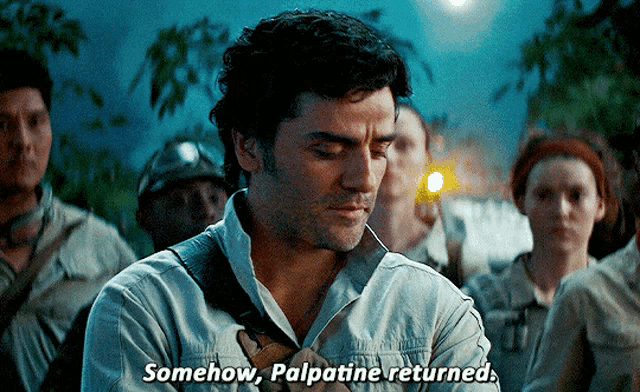
There are places I see this used and I laugh at it a lot, because I get it. But it does seem to indicate that the film offers NO possible explanations for how this happened, and just uses this line as an excuse for the character to come back. And that simply is not so.
In that very scene, someone asks “how,” and a friendly Hobbit responds with, “Dark science, cloning. Secrets only the Sith knew.” Now, alone even that is a handwave; but those comments are well into the film, and we have already seen:
A variety of machines keeping his mangled corpse alive.
Tanks full of Snokes- failed clones that were at least useful.
Palpatine speaking in Snoke’s voice when he tells Kylo Ren he WAS every voice Kylo ever heard in his head.
An entire planet full of Sith scientists, soldiers, and worshippers following Palpatine’s every wish.
The child OF a Palpatine clone who it turns out there’s a whole trilogy about.
And that’s before we even get to Tired Poe Dameron and the Friendly Hobbit.
Additionally, the movie reminds us that despite interpretation, Palpatine DOES NOT NECESSARILY FALL DOWN A REACTOR in RotJ. His throne room as that movie showed us in 1983 is at the top of a tower rising from the Death Star’s surface. The elevator doesn’t go to the core, it goes to the surface, or at least into the infrastructure where the crew operates. It’s relatively close to the equatorial trench, and Luke drags Vader to a shuttle in those docking bays. Yes, there is a flickery blue light at the bottom of the shaft, but it is poorly defined. Even assuming there is a reactor at the bottom, the release of energy we see is not from a reactor, but rather Palpatine himself who was just shooting blue lightning out of his hands, and as he “dies” there is a bunch of blue lightning released. That makes sense.
But the question does remain whether this was a clone of Palpatine in TROS or the original body re-animated, because that is honestly possible! We know his Sith minions have BEEN to the wreckage of the Death Star, because Ochi’s little dagger has a specific map to WHERE on the wreckage the tower is. So, here’s the guy we know was hunting down other Palpatine clones (like Rey’s dad) and had been to the tower. This is pretty easy to read that he HAS recovered the original corpse, the Sith machines are tying to restore it, and they hope the existing clone program can help with that.
“What do you mean existing Clone program?”
Well, let me first say, this ties to the two fundamental truths about Star Wars: It has NEVER been chronological (we start at Ep 4) and it has never been complete (even at the end of Ep 4, the Empire is standing and the fight goes on). It was 20 years before Star Wars put out prequels to describe HOW Anakin became Vader. I’ll also remind you that the word “Sith” never appears in the original trilogy. There were two DECADES of Star Wars where there was no official “rule of two.” Where we didn’t even know Palpatine WAS HIMSELF A SITH and not just some other Dark Side dude. So much of the background for the OT that is left unsaid in those films comes in later, non-chronological material, that still leaves an expansive and incomplete picture of the Universe. The Prequels still need the “Clone Wars” cartoon to flesh out many of their tenants as well. We can’t blame Disney for treating Star Wars the way George Lucas treated it from 1977 to 2014.
So, long aside, but we get the fact Palpatine is playing around with self-perpetuation for years. Even in TCW we have storylines about finding Force sensitive kids and sequestering them away. In the original expanded universe, the Zahn trilogy tells us Palpatine needed to cycle through clones every few years to stay alive. So even when there was NOTHING to go off of but the OT, writers were playing with this idea, and it bubbles under the surface of the PT and TCW (Sifo Dyas and the cloners of Kamino for instance).
Other, well regarded modern shows are playing with this too. Look at the fact a Snoke clone shows up in S2 of Mandalorian, with Grogu’s DNA used to try and help create him. The Bad Batch is showing us the Kaminoans sequestered off somewhere under Palpatine’s control right after the Clone War ended. “Oh,” that’s just a retcon,” I hear.
So were the Prequels. So was TCW. Again, this is how Lucas ALWAYS treated Star Wars.
So yes, when “THE DEAD SPEAK” in TROS, it’s a surprise, but it is not a plot device that exists in a vacuum. There is evidence in the film. There is evidence in the pre-Dinsey properties, and there is evidence still being laid out in other associated shows and films. It is not just, “Somehow.”
1 note
·
View note
Text
What in water did Bloom, waterlover, drawer of water, watercarrier, returning to the range, admire?
Its universality: its democratic equality and constancy to its nature in seeking its own level: its vastness in the ocean of Mercator's projection: its unplumbed profundity in the Sundam trench of the Pacific exceeding 8000 fathoms: the restlessness of its waves and surface particles visiting in turn all points of its seaboard: the independence of its units: the variability of states of sea: its hydrostatic quiescence in calm: its hydrokinetic turgidity in neap and spring tides: its subsidence after devastation: its sterility in the circumpolar icecaps, arctic and antarctic: its climatic and commercial significance: its preponderance of 3 to 1 over the dry land of the globe: its indisputable hegemony extending in square leagues over all the region below the subequatorial tropic of Capricorn: the multisecular stability of its primeval basin: its luteofulvous bed: its capacity to dissolve and hold in solution all soluble substances including millions of tons of the most precious metals: its slow erosions of peninsulas and islands, its persistent formation of homothetic islands, peninsulas and downwardtending promontories: its alluvial deposits: its weight and volume and density: its imperturbability in lagoons and highland tarns: its gradation of colours in the torrid and temperate and frigid zones: its vehicular ramifications in continental lakecontained streams and confluent oceanflowing rivers with their tributaries and transoceanic currents, gulfstream, north and south equatorial courses: its violence in seaquakes, waterspouts, Artesian wells, eruptions, torrents, eddies, freshets, spates, groundswells, watersheds, waterpartings, geysers, cataracts, whirlpools, maelstroms, inundations, deluges, cloudbursts: its vast circumterrestrial ahorizontal curve: its secrecy in springs and latent humidity, revealed by rhabdomantic or hygrometric instruments and exemplified by the well by the hole in the wall at Ashtown gate, saturation of air, distillation of dew: the simplicity of its composition, two constituent parts of hydrogen with one constituent part of oxygen: its healing virtues: its buoyancy in the waters of the Dead Sea: its persevering penetrativeness in runnels, gullies, inadequate dams, leaks on shipboard: its properties for cleansing, quenching thirst and fire, nourishing vegetation: its infallibility as paradigm and paragon: its metamorphoses as vapour, mist, cloud, rain, sleet, snow, hail: its strength in rigid hydrants: its variety of forms in loughs and bays and gulfs and bights and guts and lagoons and atolls and archipelagos and sounds and fjords and minches and tidal estuaries and arms of sea: its solidity in glaciers, icebergs, icefloes: its docility in working hydraulic millwheels, turbines, dynamos, electric power stations, bleachworks, tanneries, scutchmills: its utility in canals, rivers, if navigable, floating and graving docks: its potentiality derivable from harnessed tides or watercourses falling from level to level: its submarine fauna and flora (anacoustic, photophobe), numerically, if not literally, the inhabitants of the globe: its ubiquity as constituting 90 percent of the human body: the noxiousness of its effluvia in lacustrine marshes, pestilential fens, faded flowerwater, stagnant pools in the waning moon.
1 note
·
View note
Text
Planet Rosetta, Knight world with dirty secrets.
The Planet Rosetta is a Feudal Knight world under the Imperium of man, it has a trio of forge world moons orbiting it and a ring around it, the equatorial region is mostly volcanic with industrial hives standing in contrast to the alabaster stone cities elsewhere upon the world’s iron rich deserts with oasis's forming around underground springs and rivers branching from the polar seas.
Pre-Age of Strife Rosetta was once a Garden world with gleaming cities that hovered above the untouched landscapes, during the age of strife an Ork WAAAHHHG! Led by warboss “Apawfist” crashed two of its moons together and razed the planet, forming the rings around it and throwing off its rotation, triggering volcanic eruptions and crashing the cities down. These cities would join the sand of the rust deserts, and its once proud people forced to eek out survival among the ruins. During this time Weapons and tech was forgotten, leaving only tribals to fend off the Orks poorly understood machines that slowly fell apart without the knowledge to keep them in proper shape, as each knight fell to the orks, they turned to metal spears, stone and bare hand if they had too, in many ways they would become like their greenskinned foes
Great Crusade During the Great Crusade the Thousand Sons Leagion and Explorators of the Mechanicum with Legio Cybernettica support made effort to salvage the planet and its beleaguered populous, Exterminating the Orks, Salvaging whatever tech was left to recover, Building new artifical moons and setting the third to be a base for the Mechanicum. These three moons became a collective forge world, turning the planet itself into a Knight World. The Mechanicum and later Mechanicus would naturally come planet side for raw ore, and food for whatever needs they have, in return they have added some infrastructure, roads to traverse the great deserts and the volcanic divide, and knowledge of how to maintain, repair and build their Knights in return for continued service to the machine cults as well as the protection of the Legio Cybenetica and the Skitarii. This positive exposure led most to revere the Emperor in the form of the Omnissiah. Seeing Technology as a great blessing they must prove worthy of. The Ad Mech like this arrangement as it keeps the populous easily controlled. During this rebuilding time The Marines of the Thousand Sons offered assistance in educating the people, making them quite scholarly for a feudal world and impressing their architectural influences upon them. In the wake of this the knights pilots formed into the House Kepoth, Knights of the Cog.
During their Survey of the planet the Thousand Sons found an entrance to what would one day be known as a Necron Tomb, Magnus wisely ordered the Tunnel sealed off, the Mechanicum in no position to debate. Unknown to them The Tomb however was already awake waiting, watching and weighing options
Post-Heresy The Legio Cybernetica force in this system was among the few to remain loyal to the Imperium and thus had to take strict binding oaths. The People Mourned the betrayal of the Thousand Sons, the heroes who freed them from the Orks, they would remember them as they were and vowed to help destroy what they had become.
In the 41st millennium the Planet had entered a state of comparative normalcy in the Imperium, serving the forge worlds, sending people into the guard tithe and loaning out its knights at the back of their masters in the machine cult, The House itself expending to other nearby systems, but like any world has stories to tell.
Come M42 the planet is trapped behind the Great Rift, severed from the Imperium, turning to any resource and means they possess to survive and grow as the Knights make Ready for a crusade to defend and reclaim worlds, staking to expand their own territory in the name of the machine god.
Notable Post Heresy Events The Sons Gambit/Necron Revelation/The fracturing of the knights A Thousand Sons Veteran by the Name of Ramun Soket recalled his work on Rosetta , as he was one of their recorded heroes from the Crusades, Arriving in his Flag Ship "Hsagan’s Glory" with his Rubrics, Chaos machinery and a force of Nurglites called "The Noxious Bite". He had deceived the Nurglites into believing this would be a joint operation, offering the planet to Nurgle to ensure a victory for all of chaos. In Truth his intent was to only support behind the scenes so his forces could crush the Bites, stepping in as saviors once again.
Seeding the world with cultists to subvert the PDF and summon deamons was simple, as the Noxious Bite and Thousand Sons summoned terrible plagues, Rivers flowing with blood, mutant frog beasts, plague and pestilence into their house, their streams, into their streets, and bread and drink, upon their cattle and Grox, Their fields, Into their sleep and dreams, until they would break and yield.
The Knights and Skitarii rose to the challenge exterminating the cultists and horrors as best they could, holding out for marines or Guard, only to progressively call down more blows like Thunder and fire, like hail of burning ice on every town. Worse still, the warband had distorted warp traffic, the backup sent to them was now on a direct path to the war in heaven.
Blight Drones stormed the fields and forest, every stalk and leaf, threatening to leave nothing of green. The planet was on the verge of breaking, Ready for Ramun to betray the Bites and become Rosetta’s Savior anew….
Only for a different yet equally terrifying Savior to rise up from the sand, vast pylons charged and dispelled the plagues, weakening the abominations, while what the common folk of the planet could only describe as Angels of the Omnissiah blinked into existence to exterminate the rot.
What No one had known was that the Tomb world under Rosetta 's surface was a staging area for a band of shattered tomb worlds, all united by their own brokenness, the necrons in charge had been working under the planet, traversing via stargate to act on their plans, fittingly the world had at one point been touched by the Triarch between the age of strife and the great crusade, subtly ensuring the world would last just long enough to meet the crusade. The world as it currently existed was a perfect shield from scrutiny, a shield now under threat, while different lords saw the Mechanicus presence here differently (to some they were simply useful idiots, to others a sort of kindred spirit) all agreed that they needed them alive.
Naturally this left the Thousand Sons leader without a threat to easily destroy, but assumed he could use the necrons as the new threat to save them from, this backfired badly as to his shock, as he and his Rubriks strode out of their pods, that the Arch-Magos and the Phearon were Parlaying, Moreover the common folk saw the presence of the Thousand Sons Rubriks as an insult to the memory of their original saviors, ousting him as a traitor. Ramun attempted one last gambit, to tell the knights of Rosetta of the fall of Magnus, how the Emperor had sent the wolves to kill them all simply for trying to warn him, and how the metallic agents where vial xenos seeking only to destroy them. His gambit half succeeded, successfully inciting a not insignificant portion of the knights to turn traitor and join his warband.
Though the combined forces of the Mechanicus and their Skitarii, the necrons and remaining loyal knights would ultimately drive the Thousand sons off, the warband did not leave empty handed, they took many citizens of the planet captive and had a fresh set of traitors knights joining their Retinue, the all encompassing whisper “All is Dust” leaving the world feeling this was a pyrrhic victory.
In the wake of this the world was now stuck forced to keep the necrons awakening secret from the rest of the Imperium, a Tenuos co-existence also lured certain Radicals into collaborating with them, the Necrons for their part humored these radicals every once in a while with ancient or antiquidated designs they felt no current use being handed to them as bread crumbs.
Fall of Cadia With the fall of Cadia Rosetta and its surrounding worlds were left cut from the greater whole of the imperium, out of contact and iscolated they and the necrons beneath were forced to work together to defend the planet from strikes of revenge by the Thousand sons and other enemy forces. Eventually they did receive a transmission from Belisarius Cawl. Though garbled it did inform them that a leader of some sort had “returned” and was crusading to regain contact with them, as well as a critical resource for them to gather at all costs Blackstone” and its source, necron tomb worlds. Suddenly more at odds with the co-tenants of their home world than ever, the two factions constantly shift from ally to enemy as their perceived needs of mutual survival and gaining this new precious resource change in priority
Culture The planet strongly believes in a work ethic, To create is the highest virtue, seeing the ability to preform massive amounts of labor as a display of greatness, many will their bodies to become servitors should they die, notably the Mechanicus favors slightly more aware servitor variants.
The Mechanicus often recruits fresh disciples from the world, resulting in cross cultural pollination between the planet and its moons. Their cities consist of egyptian style architecture, while on earth the pyramids were simply glorified headstones, these ones have large living quarters, often serving as vast housing complexes to shelter people from the heat, or as castles for the nobility, and even as docking bays for the Imperial Knight Houses. These Pyramids often have external accouterments to accommodate living residents, like large balconies and skylights. In contrast to the Red Mars like sand, the Pyramids are white with Gold filigree familiar to the Imperium.
In more rural farming areas the people instead make cleanly formed mounds resembling pyramids to place their dwellings on top of, elevated to have a cooling cross breeze, these psuedo pyramids are often planted with lush grasses and flowers along the sides, in addition to decoration the roots serve to further support the mounds.
Along the Volcanic regions of the Equator are a small number of hive cities, used primarily to mine the raw ore from the large lava cracks, and energy harvested from the geothermal vents available to them. As far as hive cities go they are better off than some with a steady supply of proper food shipped in via caravan or railway.
The Dead are typically taken to public Mausoleum Temples resembling the ancient Terran Der El Bahri
The PDF lack much in Vehicles and weaponry, save the basic Lasguns, flak vests and such which are kept in reserve for outer planet invasion, codes in place against using them for conflicts between cities, They Make heavy use of the local wildlife to make up for this, often kitting them with large weapons, hitching hover chariots to the largest birds.
The Knights of the House Kepoth are a gilded work horse, when not in combat or being maintained, the Knights typically take part in helping build/rebuild the cities, going back to the work ethic. Rosetta not being the Only world the House presides over, it is however their Home World.
Ecology
Most native vertebrate life is Reptilian or Avian, often blending the two, what mammals live are aquatic or amphibious specialists, large insects make up a large portion of the fauna
Plants are fairly normal though many of them have Blue leaves
The planet also has feral Orkid life that has been assimilated into the ecology, leaving some places as fungus forests prowling with squigs and the occasional Gretchin or Snotling for the PDF to train against
Notable animals
The Greater River Amitaspinax
resembling what a 2n'd millenium paleontologist would call a spinosaurus with a feathered mane, they are Apex river predators who's behavior can be described as a mix of crocodile and Lion, they Prey on most anything, either ambushing land prey from under water, or fishing on the bank for fresh water sharks, smaller breeds exist. But a well tamed one of the Greater breed is a well sought prize of noble families.
Jakowls
Dromiosauroid creatures with beaked faces resembling a Terran owl, they hunt in packs across the deserts and plains, Tamed like any dog, they are favored pets and the largest breeds can even serve as mounts for their rough riders
Apep Sand Serpent
large, venomous snakes capable of swimming through the loose rusty sand, capable of striking without warning, they are the most feared predator of the planet. Their hooded hides and rattles are prized trophies
Phoenix vulture
Great flyers resembling a mix of a bearded vulture and a microraptor, they fly long trips on the planets thermals seeking easy prey and carrion, sometimes used to ship supplies on hover platforms across the world
Geboliths
Large tortoises that graze on foliage, they grow seeds in their back, the plants leach water from the spongy tissue under their shells, in turn these plants enrich them with sugars via photosynthesis, sometimes however they can grow carnivorous plants, given the size of these creatures these carnivorous plants be very dangerous and the tortoise becomes known as Man-eater-backs, otherwise they make superb livestock, able to serve as mobile groves, traveling with the water and can serve as meat too.
Grox
Ordinary Grox , imported to the world for hide and meat.
Mantadon
Thought to be transplanted in the early days of colonization from what is now thought to be the Home world of the Mantis Warriors Space Marines Chapter, presumably to help deal with the pests now known as Rust Roaches and Keprikets. These are large Solitary Insects, prowling savannas or hiding in trees to ambush prey and are about the size of a Prehistoric Terran Smilodon, otherwise Resemble a large Mantis.
Keprikets
Winged arachnid creatures who live in antlike colonies, supporting the tunnels with a network of webbing, the size of large wolves they are dangerous and troubling, they carry food, building material and meat in large rolled balls, only recently have any means of taming them with harvested queen pheromones been found, their shells make fine decoration and silk incredibly versatile.
Rust Roaches
raccoon sized Roaches that live in rust
Kirradon
a Sauropod that slimmed down, tall like a Giraffe, but some similar more stalky breeds exist
Hyppoderm
an Amphibious Elephant breed, bearing a total of six tusks, 4 external and an inner set, though herbivorous they are terribly aggressive and territorial beasts, competing with Amitaspinax for river territory, Only the largest with seeds in their back like that of the Geboliths, ever go far from land
Red River Shark
Large fresh water Sharks resembling sting rays that prowl the rivers
Icthysuchas
Fully aquatic reptiles that live in the north polar sea
Coolacetus
Car sized otter/dolphin like creatures, some in hairy or smooth variety, living south of the Volcanic Equator
#warhammer#40k#wh40k#ad mech#Adeptus mechanicus#imperial knight#necron#thousand sons#homebrew lore#worldbuilding#history#text only#fictional ecology#long post
9 notes
·
View notes
Text
Sunday Respite - Going to Town
Those fabled, cobble streets and crooked alleyways hide secrets that even the sewer rats may not know. The leaded roof tiles and wiry thatch paint the urban horizon with the dour grey and off-yellow pallet seen upon the mournful faces of the weakened plague victims.
Adventurers in tabletop games are traditionally associated with dungeon exploration and travel, fathoms underground and stretches out of common sight. It was only a good decade into the maturity of the industry that players began to experience a wider plethora of locales to delve into. Those who once had remained chained by the ankle to cavernous castle hallways and howling passages of cyclopean stone now could roam free. Ancient, Elven glades, roaring, wild swathes of ocean brine, and - more importantly for today - all sorts of city-scapes.
Today, I implore you to follow me closely down the shadow-painted roads and gleaming, freshly-scrubbed marble pathways. I hope they inspire you in the future in all facet of creative art and design that you approach. Just keep an open ear, a sharp eye, and one hand on your purse and the other at your sword. We can never be too careful, not in these parts.
Nepulas, the Wounded City
Nepulas was once a gleaming democracy on the shore of a calm and tidy bay. Its ivory-white marble structures shone with not only the radiance of a equatorial sun, all year-round, but also with the ingenious pride of the hundreds upon hundreds of artists and architects who carved them out of the earth itself with chisel and hammer. Now, the bay lies in fragmented islands, following a disastrous mishap of unknown magics. The city was thrust hundreds of feet up and away from the water upon a raised stack of chalky rock with half of the township lost to the sea in collapsing debris. The survivors of the maelstrom found that they were now separated from the rest of the nation; severed off by the cruel blade of a wicked, eternally storm-ridden sea that now swills around the base like a stirred cocktail. Every year, more neighbourhoods plummet away like slices of pie into the sea. Every year, the city becomes more cramped. The piers have been adapted into a docking bay with a heavy crane as its centerpiece. It reaches down to the sea below and lifts trade boats and travel ships up to the city or back down to the waters. Those who cannot afford to pay for their stay may find their boats dropped, unceremoniously, back to the depths beneath the dockmaster’s uncaring gaze.
Eradith, the Allhouse
Many foreign journeymen and women are confused as to just why there are hundreds of busying farms out amongst the wilderness, seemingly with no destination for their produce. Eradith is a city that you could easily miss on your travels. Only three, ragged and dusty roads lead to the arrow-pocked city walls and towers, and the Allhouse itself is obscured between four different wheat fields of four different farmers, which each outsize the city itself by almost a third of its landmass. An approach to the city is a confusing one. A traveler may expect the distant structures on the horizon to grow in size as they near. Instead, the traveler finds that they themselves begin to slowly shrink and shrink until the wheat fields tower over them on either side. The city itself is a fully-functioning community built around the river that narrows like a bottleneck upon its breach of the city wall to a fraction of its original girth, but no less than its original momentum. The river feeds into a canal system of three branching rings, each hosting a different marketplace, before once again leaving Eradith and widening once more as if it had never changed. Those who choose to leave the city find that the reverse process is slightly nauseous, but not at all painful as an experience as they return to the norm of seeing over the endless barley fields once more.
Oldscope Tower
The city that preceded Oldscope Tower and her residents died long ago to an end that history didn't deem worth remembering. Its skeletal foundations scarred the grasses like runic tattoos on a Minotaur's grizzled forearm. Something about its demeanor inspired some maddened wizard to construct an impressive tower right in the centre of the scattered stonework and bricks. Its blue-tiled beacon brought homeless travelers and gypsies to settle under her shadow. Eventually, a community of regulars formed under the magician’s benevolence and the township of Oldscope formed, with the wizard taking the titles of mayor and court-wizard at once. His oversight brought business, health, trade, and all the benefits that his magic could afford to his people. He spend every last etch of his power into building a safe home for those below. His eventual death brought generations of court-wizard mayors to oversee the expansion from a dribbling of infrequent arrivals to a coursing vein of the nation’s trade and political wealth.
Greaveston
In the kingdom of Adol, criminals are treated with no mercy. The thieves, killers, cheats, and brutes all meet the same fate. They are shackled and stocked onto a rattling cart with all that they own by grim-faced guardsmen. The cart rumbles down the swampy paths and far from whatever land they may call home, and then beyond whatever borders they know. Within the feral wilderness is the moonlit city of Greaveston, plagued by crows and crime; for that is all there is. Every criminal is sent to this swarming chaos of traitors and left to live as they chose. The city was originally an enormous temple complex of a forgotten religion, complete with snaking tunnel ways and echoing church halls of worship. Now, thousands of every colour and creed bustle amongst the dark, fighting for survival and beyond out of the lawful citizen’s sight and beyond their care.
Olraven
Olraven sits at the foot of a ruined manor house of a hundred bygone generations. It is a place of horror and despair, with terrible creatures of malformed construct meandering through the house grounds without goal other than the violent death of all intruders. The most recent heir of the estate died by her own doings, but her last willful act was to summon what distant and depraved family she had left in one final bid to reclaim their namesake; a vast fortune beyond equal. The township below used to house the servants and staff of the family in question. The smithy lies empty, the tavern is boarded over at every window and door, and the church’s window panes lie shattered and spent across the pews in discoloured shards. However, one particularly morbid day finds Olraven welcoming several noblemen at her doorstep. The boots of the esteemed bring forth the greeding, nose-raised aristocrats that were sent for by letter all those months ago. With them, they have brought a smith to rekindle the forge, a priest to reignite the faith of men, and enough wine and brandy by the barrel to feast for months. Following them across the weed-strewn roads are mercenary folks of all sorts and styles, paid well to reclaim the treasures within Olraven manor. It will be a long campaign; a costly one, too. But they will endure. Rumour is that whatever wealth lies within is also the cause of the family’s collapse. A terrible power that just begs to be harnessed.
Enjoy
Pixie x
19/06/17
127 notes
·
View notes
Text
Your master plan for creating a new city from scratch
*Dates back to 2015, but not a lot has changed since. Interestingly, you never see a new town in the ranking of “smart cities.” Probably because “smart city” rankings have all kinds of warm-and-fuzzy things going on about “liveability,” while the people who try to inhabit new towns have the stressed-out lives of pioneers.
https://www.theguardian.com/cities/2015/jun/30/how-build-city-step-by-step-diy-guide
Step 1: Choose a location
Before you begin, you need a spot. Deserts, undeveloped jungles and uninhabited islands are popular: you don’t want to sink your budget into detoxifying brownfield sites, bulldozing slums or fighting legal battles over ancestral land rights. Plus, very few camels attend planning meetings, still less are they capable of forming coherent objections to your masterplan for a desert metropolis.
Tajikistan’s president, Emomali Rahmon, recently laid the foundation stone for Saihoon, a new city for 250,000 people on a 14,000-hectare (34,580-acre) desert site. When complete, it will have 19 residential districts, 50 schools, 40 sports centres, shopping centres and bazaars – and, my favourite design feature, 7,000 hectares (17,290 acres) of orchards blooming in the former desert. Egypt’s new capital, too, is going to be built on sand – to the east of Cairo, its functionally inadequate predecessor. Meanwhile, President Teodoro Obiang is currently overseeing the creation of Oyala as his new capital deep in the jungle of Equatorial Guinea, remote from the seaborne assaults that have menaced the dictator and his government in the existing capital. Crystal Island was to be built on a river island near Moscow.
If you don’t have a desert or uninhabited island to hand, build one. Songdo, the new city near Seoul in South Korea, is built on land reclaimed from the Yellow Sea. In the early 1960s, Buckminster Fuller dreamed up a giant floating pyramid in Tokyo Bay which would have housed 1 million people – in part as a response to the problem of acquiring building land in Japan. Perhaps sadly, it never got built.
Step 2: Ensure a reliable water supply
This may sound elementary, but consider what happened to the city of Fatehpur Sikri. The Mughal emperor Akbar commenced the construction of this walled city in 1569, to serve as the Mughal capital. Over the next 15 years, he and his lackeys built royal palaces, harems, courts, mosques and private quarters, all from locally available red sandstone. Shortly after completion, however, Akbar abandoned Fatehpur … in part because of inadequate water supplies.
Today, Rawabi – the first Israeli city built for Palestinians – has a similar problem. Work started in 2011 and, when complete, it will have homes for 40,000 residents, as well as cinemas, shopping malls, schools, landscaped walkways, office blocks, a conference centre, restaurants and cafes. But, until as recently as this spring, apartments stood empty because negotiations failed with Israeli authorities over connecting the city to the country’s water grid.
Step 3: Ensure a reliable money supply
Again this may sound elementary, but you don’t want to run out of liquidity halfway through building the high-speed train link to the financial quarter. There are various options available to you when it comes to securing the cash. Rawabi, denounced by some Palestinians for normalising Israeli occupation and by some Israelis for the possibility of providing a base for terrorists, has drawn a third of its $1bn (£640m) investment from the private Palestinian conglomerate Massar International, and the rest from Qatar.
Oyala has been described as “a multibillion-dollar plaything for Africa’s longest-serving dictator” and is funded chiefly by oil, timber and gas revenues. Equatorial Guinea is the third largest sub-Saharan oil producer, and much of that money is being lavished on the new capital, which will have a championship golf course, the Library of Central Africa (which looks like a spaceship docked in a jungle clearing), a luxury hotel and a presidential villa. Meanwhile, according to the International Business Times, “the people are starving”.
In Egypt, the nameless 700 sq km city that is set to replace Cairo as the country’s capital will be partly funded by Emirati businessman Mostafa Madbouly, who recently unveiled the £30bn project’s plans. He told Guardian Cities that he already has the money to build at least 100 sq km of the new capital, including a new parliament. But he needs more: which is why he invited kings, presidents, 30 visiting emirs and hundreds of would-be investors to the March launch at Sharm el-Sheikh.
Step 4: Think about jobs
If your city is to be economically sustainable, it needs jobs. Herbert Girardet, author of Creating Sustainable Cities, argues that Egypt’s planned new capital has a better chance of success than other purpose-built Egyptian cities, mainly because the vast government will be relocated there. Indeed, many of the most famous planned cities were new capitals – Brasilia, Canberra, Abuja, Canberra, Ottawa, New Delhi – that, whatever their other shortcomings, benefited from the employment opportunities and economic uplift of being a national administrative hub.
Step 5: Do not alienate locals
Don’t do what they did in Lavasa. The first three of 100 smart cities that prime minister Narendra Modi is planning in India will be built as part of the Delhi-Mumbai Industrial Corridor, which the government aims will be a “global manufacturing and trading hub”. They’re planning animation and film studios, software-development companies, biotech labs, and law and architectural firms, focusing the knowledge industries at the heart of the “new India”.
However, the 12,500-acre site has been controversial, upsetting some locals and environmental groups. In 2010, the Indian Environment and Forests ministryordered that construction on Lavasa cease temporarily, saying the developers had failed to obtain the mandatory environmental clearances.
Step 6: Devise a masterplan
You don’t even need to set foot in the country where your plans will be realised. For example, Garsdale Design, which specialises in masterplans for war-ravaged cities in Iraq, is a family practice operating out of a converted barn in the Yorkshire Dales. Such 3D modelling applications as Esri CityEngine make it possible to devise city masterplans for homes, sewerage, water and electrical systems and integrated public transport, and then to amend these plans according to the needs on the ground. Increasingly, too, masterplans involve setting out Wi-Fi hotspots, fibre-optic grids and sensors (more on this below).
Step 7: Integrate transport
Narendra Modi’s 100 planned cities in India all involve integrated transport with bus rapid transport (or BRT, a sort of overground metro system), suburban trains and cycle networks. Smart transport might well mean digital parking meters that text you when a parking space opens up, or real-time transport displays that give data about traffic jams, availability of buses and train services. Helsinki – admittedly not a planned city, but a good model to follow – is going so far in the integrated transport direction as to say that private cars may soon be obsolete.
Step 8: Consider banning cars....
0 notes
Text
Trade Federation Battleship
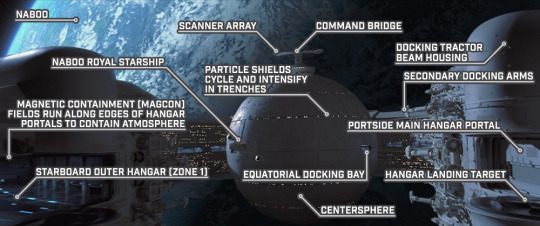
STAR WARS EPISODE I: The Phantom Menace 00:26:38
#Star Wars#Episode I#The Phantom Menace#Naboo Royal Starship#Naboo#scanner array#command bridg#particle shields#magnetic containment field#magcon#hangar portal#starboard outer hangar#zone 1#equatorial docking bay#centersphere#docking tractor beam housing#secondary docking arms#portside main hangar portal#hangar landing target#Lucrehulk-class LH-3210#Trade Federation battleship#Trade Federation blockade#Blockade of Naboo
0 notes
Text
Inner Wall Explosions
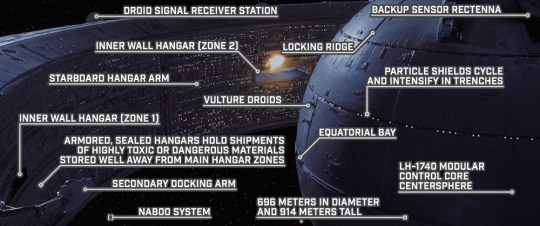
STAR WARS EPISODE I: The Phantom Menace 02:03:02
#Star Wars#Episode I#The Phantom Menace#Naboo system#Battle of Naboo#Vuutun Palaa#Droid Control Ship#Lucrehulk-class LH-3210#LH-1740 modular control core#droid signal receiver station#inner wall hangar#starboard hangar arm#Vulture droid starfighter#Zone 3#Zone 1#secondary docking arm#backup sensor rectenna#locking ridge#particle shield#equatorial bay#centersphere
0 notes
Text
Anakin Flies Past the Portside Hangar
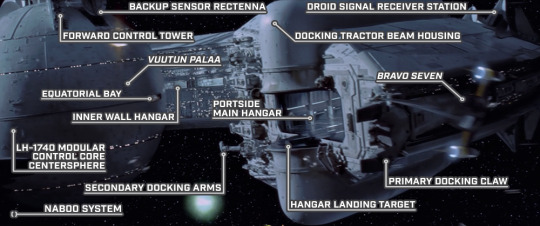
STAR WARS EPISODE I: The Phantom Menace 01:54:13
#Star Wars#Episode I#The Phantom Menace#Battle of Naboo#Naboo system#N-1 starfighter#Bravo Seven#Vuutun Palaa#Droid Control Ship#Lucrehulk-class LH-3210#LH-1740 modular control core#backup sensor rectenna#forward control tower#equatorial bay#inner wall hangar#centersphere#secondary docking arms#portside main hangar#droid signal receiver station#docking tractor beam housing#primary docking claw#hangar landing target
0 notes